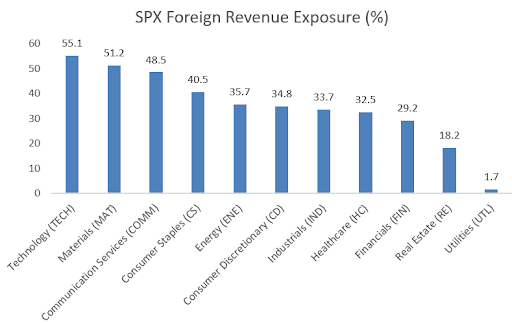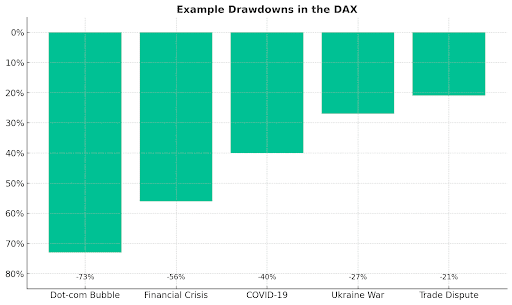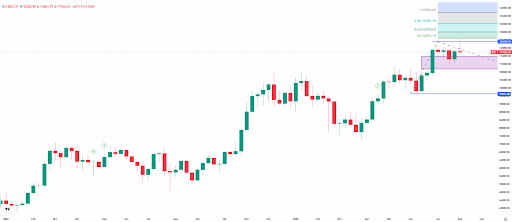Jackson Gap is within the highlight, and Powell’s phrases on charges may steer markets for months. Traders are betting peak charges are behind us, with cuts on the horizon. That’s excellent news for rate-sensitive corners like REITs, the place earnings are stabilizing and selective alternatives are rising. Add in resilient investor habits and a still-intact Bitcoin uptrend, and the week is shaping up with extra causes for optimism than concern.
Sector Focus: REITs – Past the ‘Workplace Apocalypse’
The Setup: Charges Are Peaking, Cuts Looming
The actual property sector, notably REITs, has been battered over the past two years by rising rates of interest. Greater low cost charges compressed valuations, whereas refinancing danger loomed massive for levered steadiness sheets.
Now, with fee cuts on the horizon and markets starting to cost in a 2026 restoration, sentiment is slowly shifting. Regardless of uneven Q2 earnings outcomes, most subsectors are guiding to stabilization or restoration.
The place’s the Worth?
The strongest outlooks got here from datacenters, healthcare, industrial, manufactured housing, internet lease, single-family rental, and towers. Extra challenged teams included chilly storage, lodging, multifamily, and self-storage.
The market assumes fee cuts into 2026 will reflate the house. Which will assist, however counting on macro alone is harmful. The higher technique is to concentrate on an lively choice course of, gauge resilient tenants, steadiness sheets, and money flows and to purchase solely the place costs already replicate extreme pessimism.
Workplace: Extra Noise Than Weight
The “workplace apocalypse” nonetheless dominates headlines, however listed REIT publicity tells a special story. Workplace now makes up simply ~1% of the sector’s weighting after large NYC names like Vornado and SL Inexperienced had been dropped. The actual property index is ~80% concentrated in residential, industrial, healthcare, and specialised REITs, which don’t face the identical structural challenges.
That mentioned, selective alternatives exist. Douglas Emmett and Hudson Pacific delivered strong outcomes, however coastal workplaces stay fragile. Cousins Properties (Sunbelt) and COPT Protection (authorities/IT tenants) provide extra defensible niches the place tenant demand is stickier.
Datacenters: Secular Development, However Thoughts the Worth
Datacenters stay one of many sector’s strongest tales. Earnings outlooks are intact, supported by secular drivers similar to cloud adoption, AI workloads, and rising demand for digital infrastructure. Operators like Equinix and Digital Realty proceed to profit from pricing energy in interconnection and long-term contracts.
However, enthusiasm is excessive, and valuations already replicate portion of the expansion. The group has turn into a consensus “protected harbor” for buyers rotating into REITs. For disciplined capital, meaning alternative solely emerges when market sentiment swings too far, both by generalist profit-taking or broader sell-offs that drag the sector down. The higher entry factors will are available moments of volatility, when sturdy fundamentals quickly get marked down with the remainder of the sector.
Healthcare: Sturdy Demographics
Healthcare REITs quietly constructed momentum. CareTrust is increasing its senior housing pipeline, and execution within the second half of the 12 months may beat longer-term expectations. NHI lastly noticed its SHOP portfolio ship margin enlargement. With an growing older inhabitants underpinning regular demand, healthcare stays one of many few areas the place defensive money flows and demographics create a margin of security.
Lodging: Quick Length, Excessive Beta
Accommodations face softer Q3 comps and stronger This autumn expectations. Share repurchases funded by asset gross sales are a theme, however money flows stay extremely cyclical. With out true misery pricing, lodging lacks the draw back safety required for long-term capital.
Macro Watch: What’s Driving REITs Past Earnings
Cap charges vs Treasuries: Cap charges have recovered from pandemic lows, however Treasury yields have too. Spreads stay beneath historic averages, leaving REIT valuations much less compelling relative to bonds.
Debt maturities: About 8% of REIT debt comes due within the subsequent 12 months. Rising refinancing prices are biting, although nonetheless manageable. Credit score charge-offs are climbing however stay far beneath recessionary peaks.
Tariffs: Actual property is likely one of the least uncovered sectors to tariffs (solely ~18% of revenues from overseas). Nonetheless, tariffs may push up building prices and not directly stress yields.
Valuations: REITs commerce at ~17x ahead FFO, according to post-GFC averages, not stretched, however not screamingly low cost both.

Sentiment Shift
Investor tone is shifting from “Ought to we reset expectations?” to “The place will we purchase the dip?” Generalist cash is beginning to sniff round, which might help near-term efficiency. However true worth normally emerges the place capital has already left, in underfollowed niches and misunderstood steadiness sheets.
Investor Takeaway: The rubble in REITs affords selective alternative. The actual story is much less about an workplace collapse and extra about discovering resilient tenants, steady steadiness sheets, and money flows that may stand up to increased charges. These are the locations the place capital is most probably to compound, with or with out the Fed’s assist.
Volatility Is Not a Flaw, It’s A part of the Recreation
As we speak’s market construction is considerably extra resilient than it was just a few many years in the past. As we speak’s buyers are extra knowledgeable, long-term oriented, and disciplined. This shift is supported by automated ETF financial savings plans, common portfolio rebalancing, and a typically increased degree of monetary literacy. In line with the Q2 Retail Investor Beat, 35% of German buyers make their purchases commonly or by automation, no matter market circumstances. Volatility stays part of on a regular basis market exercise, however it’s not seen as one thing to concern. It’s more and more accepted as a pure characteristic of functioning capital markets.
Many buyers now view durations of weak point not as a menace however as an entry alternative. One in 5 German buyers buys throughout a market pullback of 11% to twenty% (Retail Investor Beat). Dips of three% to five% in indices just like the DAX or S&P 500 are frequent and happen a number of occasions a 12 months. Corrections, outlined as declines of 10% or extra, usually occur about annually. Even bear markets with losses exceeding 20% haven’t disappeared over the previous 25 years, however they usually unfold extra reasonably than they as soon as did (see chart). This displays a rising diploma of market resilience.
Traders who keep calm throughout such phases and purchase in constantly are likely to outperform over the long run. Traditionally, persistence mixed with disciplined shopping for throughout downturns has usually delivered higher outcomes than attempting to completely time the market. Even somebody who invested within the DAX on the peak of the dot-com bubble would have practically tripled their capital by now, rather more with common contributions.

Bitcoin: Failed Breakout, however Uptrend Intact
Final week, bitcoin shaped a candlestick with an extended higher wick. At one level, BTC climbed to a brand new all-time excessive above $124,500. The breakout lacked follow-through, resulting in a spherical of short-term profit-taking. The Honest Worth Hole between $109,500 and $115,900 now acts as a key help zone. So long as this space holds, the potential for one more upward breakout try stays intact. Primarily based on the Fibonacci extension, potential upside targets are positioned at $128,000, $132,000, and $138,000. If help fails to carry, the correction may lengthen in the direction of the low of $97,000.


This communication is for data and training functions solely and shouldn’t be taken as funding recommendation, a private suggestion, or a suggestion of, or solicitation to purchase or promote, any monetary devices. This materials has been ready with out considering any explicit recipient’s funding goals or monetary state of affairs and has not been ready in accordance with the authorized and regulatory necessities to advertise unbiased analysis. Any references to previous or future efficiency of a monetary instrument, index or a packaged funding product are usually not, and shouldn’t be taken as, a dependable indicator of future outcomes. eToro makes no illustration and assumes no legal responsibility as to the accuracy or completeness of the content material of this publication.








